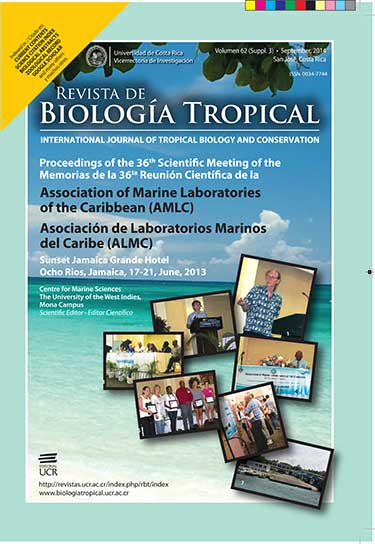Resumen
La ciencia de la sostenibilidad puede, a través del desarrollo de capacidades, permitir la gestión integrada de los actores interesados en estos ecosistemas marinos vitales del Caribe. Realizamos un ejercicio de desarrollo de capacidades en dos importantes arrecifes de coral al sur de Belice. El resultado clave fue el desarrollo de un plan de acción personal/profesional de seis meses para cada participante sobre técnicas para liderar, educar y apoyar los problemas acerca del desarrollo sostenible y técnicas para influir en decisiones políticas. Nuestros resultados se pueden ejecutar a lo largo de todo el Caribe.
Citas
Cho, L. (2005). Marine protected areas: a tool for integrated coastal management in Belize. Ocean and Coastal Management, 48, 932-947.
Crabbe, M. J. C., Martinez, E., Garcia, C., Chub, J., Castro, L., & Guy, J. (2010). Is capacity building important in policy development for sustainability? A case study using action plans for sustainable Marine Protected Areas in Belize. Society and Natural Resources, 23, 181-190.
Eakin C. M., Morgan, J. A., Heron, S. F., Smith, T. B., Liu, G., Alvarez-Filip, L., Baca, B., Bartels, E., Bastidas, C., … , & Yusuf Y. (2010). CaribbeanCorals in Crisis: Record Thermal Stress, Bleaching, and Mortality in 2005. PLOSONE, 5(11), e13969. doi:10.1371/journal.pone.0013969
Gray, T., & Hatchard, J. (2008). A complicated relationship: stakeholder participation and the ecosystem-based approach to fisheries management. Marine Policy, 32,158-168.
Jorge, M. A. (1997). Developing capacity for coastal management in the absence of the government: a case study in the Dominican Republic. Ocean and Coastal Management, 36, 47-72.
Kaplan, M., Liu, S-T., & Hannon, P. (2006). Intergenerational engagement in retirement communities: a case study of a community capacity-building model. Journal of Applied Gerontology, 25, 406-426.
Keller, B. D., Gleason, D. F., McLeod, E., Woodley, C. M., Airame, S., Causey, B. D., Friedlander, A. M., Grober-Dunsmore, R., … , & Steneck, R. S. (2009). Climate Change, Coral Reef Ecosystems, and Management Options for Marine Protected Areas. Environmental Management, 44, 1069-1088.
McCance, T. V., Fitzsimons, D., Keeney, S., Hasson, F., & McKenna, H. P. (2007). Capacity building in nursing and midwifery research and development: an old priority with a new perspective. Journal of Advanced Nursing, 59, 57-67.
McDuff, M. D. (2001). Building the capacity of grassroots conservation organisations to conduct participatory evaluation. Environmental Management, 27, 715-727.
Mequanent, G., & Taylor, D. F. R. (2007). The big push approach to African development and local capacity building: understanding the issue. Canadian Journal of Development Studies, 28, 9-26.
Mumby, P. J., Hastings, A., & Edwards, H. J. (2007). Thresholds and the resilience of Caribbean coral reefs. Nature, 450, 98-101.
Rogers, J. L., Johnson, T. R. B., Warner, P., Thorson, J. A., & Punch, M. R. (2007). Building a sustainable comprehensive Women’s Health program: the Michigan model. Journal of Women’s Health, 16, 919-925.
Sample, J. A. (1984). Nominal group technique: an alternative to brainstorming. Journal of Extension, 22(2), 1-2.
Söderholm, P. (2012). Modeling the Economic Costs of Climate Policy: An Overview. American Journal of Climate Change, 1, 14-32.
Wescott, G. (2002). Partnerships for capacity building: community, governments and universities working together. Ocean and Coastal Management, 45, 549-571.
Williams, I. D., & Polunin, N. V. C. (2000). Differences between protected and unprotected reefs of the Western Caribbean in attributes preferred by dive tourists. Environmental Conservation, 27, 382-391.
Comentarios

Esta obra está bajo una licencia internacional Creative Commons Atribución 4.0.
Derechos de autor 2014 Revista de Biología Tropical






